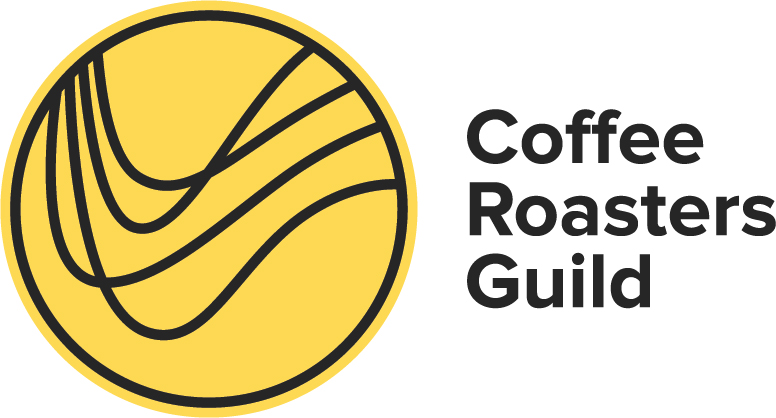Celebrating Our History: The Founding of the Roasters Guild
Important milestones such as birthdays, anniversaries and commemorations of important events are celebrated with fanfare and jubilation. To those of us in the specialty coffee community who are of a certain age, celebrations often include a stroll down memory lane and usually begin with, “Remember when?”
Today, when the Coffee Roasters Guild gathers, many of the most respected specialty coffee professionals in the industry are in the room. For beginners and industry luminaries, the feeling of being amongst kindred spirits is tangible; as coffee roasters, we are connected—unconcerned with titles, pretense or formality. This was always the goal.
This year as part of our 20th anniversary celebration, we are telling the story of the early years of the Roasters Guild through the accounts of its founding members. We contacted members of the first Roasters Guild Executive Council to obtain their recollections and impressions of the early years. We also reached out to Donald Schoenholt, President of Gillies Coffee, and Don Holly, Director of Technical Services at Rhino Foods, who was the administrative director of the Specialty Coffee Association of America (SCAA) between 1995 and 2001. Both were instrumental to the formation of the Roasters Guild.
“There was some tangible angst expressed by the critical mass of roasters that the SCAA was not properly, or proportionally, serving,” Holly recalls.
The Town Hall Breakfast at the 1994 SCAA Conference is where Schoenholt begins his story. During the open discussion, specialty roasters stepped to the microphone to decry the lack of a Roasters Track at the conference. This is the precursor to what would become the Roasters Guild. “What had begun as a gripe session, was turning into a chorus of revolt,” Schoenholt says. The Roasters Track was subsequently created under the SCAA educational umbrella. During the next few years, with the help of many industry leaders, the Roasters Track expanded in scope of sophistication.
Early SCAA classes were mostly lecture-based, even for cupping and blending classes. Slowly, hands-on classes were developed for many functional skills. Cupping classes in the late 1990s were organized in hotel ballrooms with protracted rows of rectangular banquet tables, placed end-to-end and stretching the length of the room, each row with dozens of coffees on each side of the table. After several back-breaking years of leaning over to cup coffee for workshop attendees, the SCAA ultimately determined that the table height needed to be raised for ergonomics.
Coffee roasters’ craving for comprehensive hands-on roasting classes with sample, small-batch and production equipment was evident. The absence of practical experiential training for coffee roasters was frustrating until the 2000 conference in San Francisco, when an assortment of coffee roasting machines was set up on the rear loading dock of the convention center. “Prior to that, we had not been able to figure out how to have a Fire Captains’ worst nightmare be conducted in a public space,” laments Holly. The assemblage in San Francisco was replicated the next year in Miami and has become the model for the roasting tent at Roasters Guild Retreats.
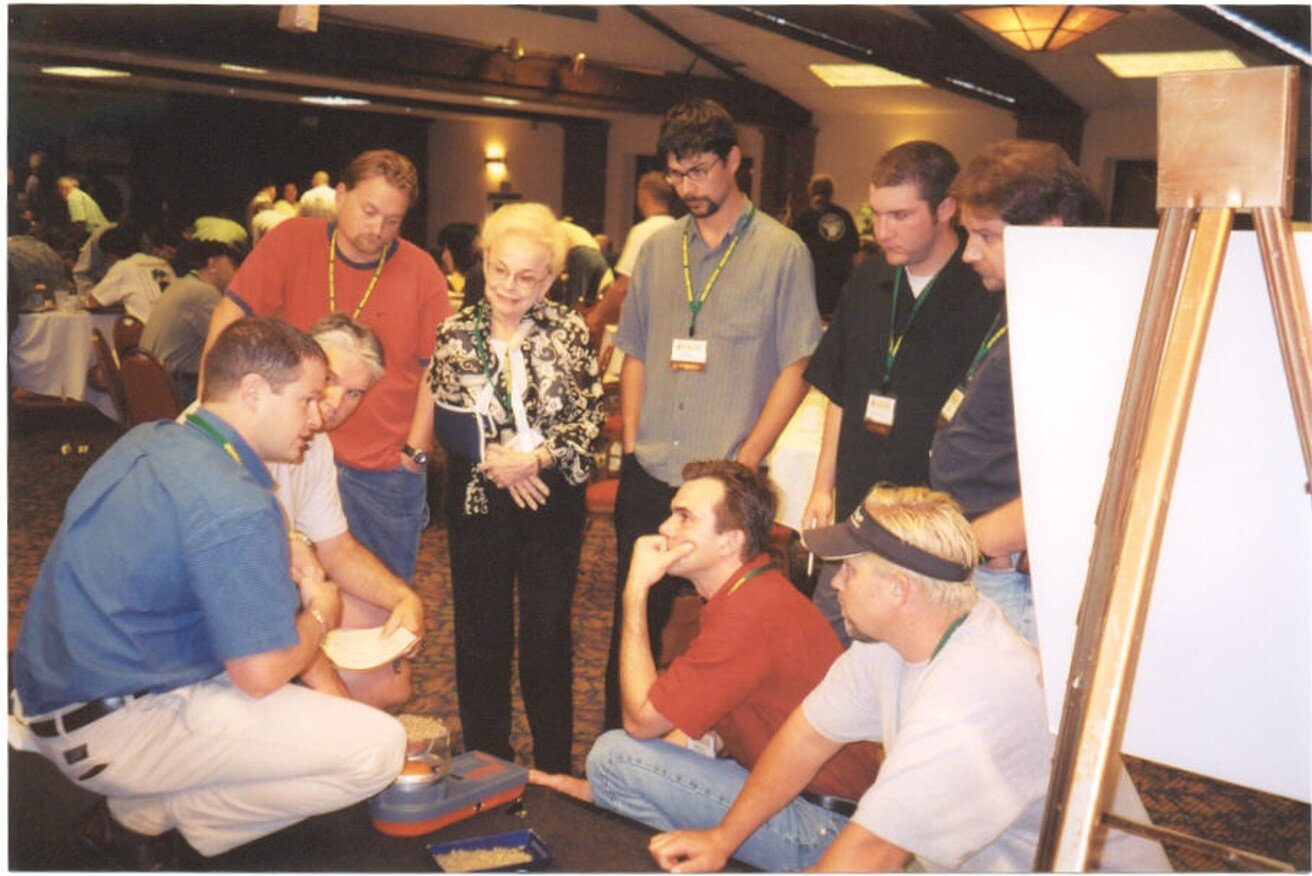
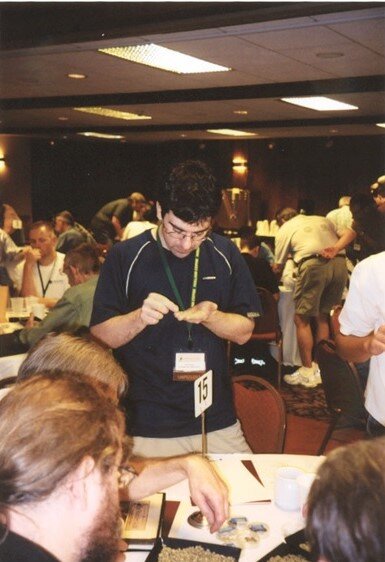
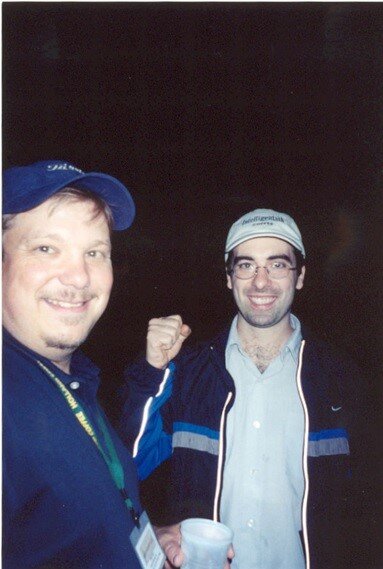
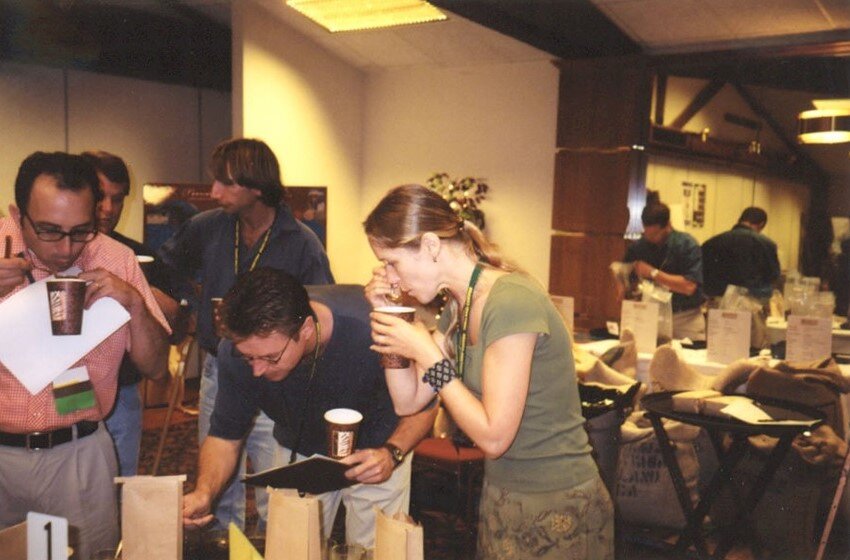

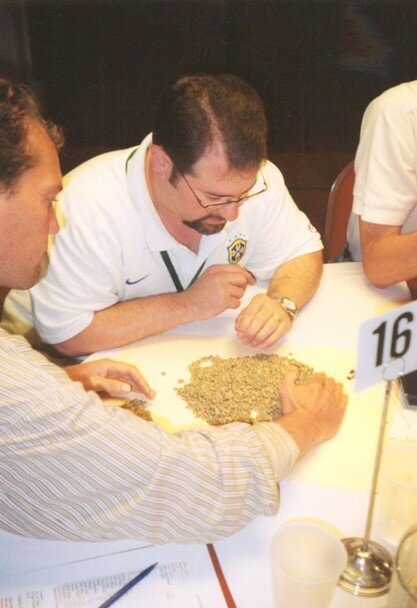
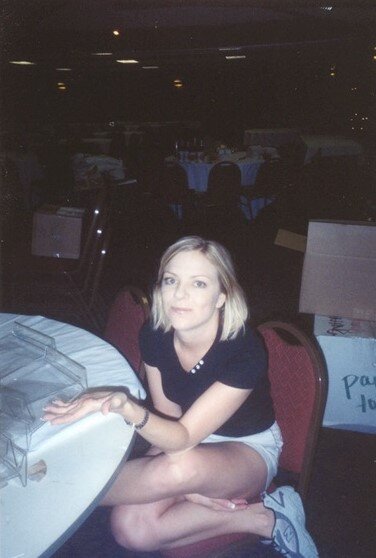
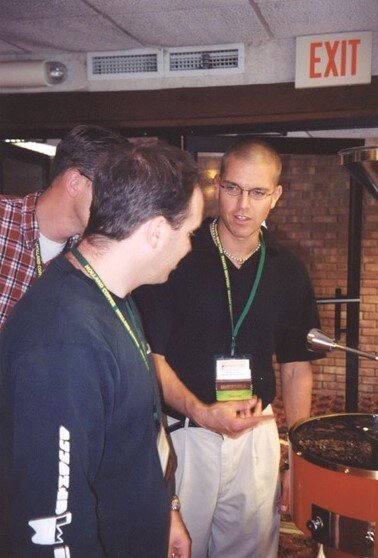
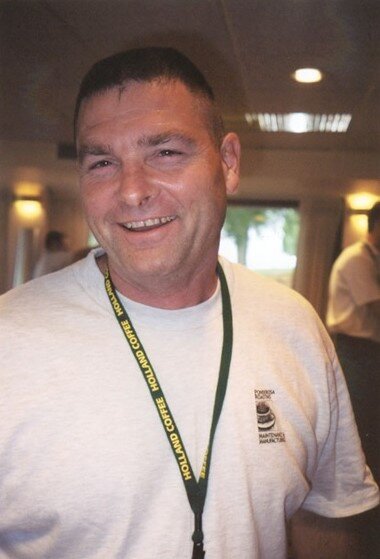
For historical context, the SCAA membership was about 2,500 businesses (roughly 10,000 members) in the late 1990s, and the organization was staffed by less than a dozen people. In an effort to foster professional connections and facilitate conversations, the SCAA hosted roundtable discussions at the annual conference. These were round banquet tables identified by topic or industry segment, where people would gather and talk about coffee.
“My thoughts ran toward a group-within-a-group organization for roasters, parallel to the special interest ‘caucuses’ in Congress, rather than the formation of a new trade group separate from the SCAA,” says Schoenholt. Ted Lingle, executive director of the SCAA, and Holly collaborated to create a roasters’ association within the Association. Holly recalls, “The name of the ‘guild’ came from my research into medieval craft associations that were inspiring because they have the same needs and strategies as did our modern specialty industry.” The role of historical guilds was easy to conceptualize and transfer to coffee roasters—the principal role is to promote quality and increase the value of their industry through personal bonds committed to knowledge, skills, and livelihood. “Erstwhile competitors collaborating for the sake of the greater good,” adds Holly.
A sign of the times, “The Roasters Guild listserv is a usually overlooked, but very important stage of the guild’s founding,” says Peter Giuliano, who now serves as the chief research officer of the SCA. “I remember there being active debate on those emails—I wish I could remember what those debate topics were! As a young coffee roaster eager to expand my knowledge, I remember feeling inspired and excited by those discussions, and feeling I had found a home among those as passionate as I was about coffee.” (Yes, we had the world wide web prior to the turn of the century. For historical reference, Listserv is an email-based program that distributes a single email to all subscribers to the list.)
By 1999, when the SCAA conference convened in Philadelphia, the Roasters Guild was gaining momentum. At the roasters’ roundtable, the conversation percolated with excitement as 25 people registered for membership and many ideas about the operation and function of the guild were discussed. There were many contributors to the guild in the beginning—specialty coffee professionals who borrowed ideas and exchanged concepts from within their companies and from prior SCAA activities to help develop the Roasters Guild. Mike Ebert, co-founder of Firedancer Coffee Consultants, describes the evolution: “It was the spring of 2000, and the annual SCAA event was in San Francisco. By this time, the annual ‘Roasters’ Roundtable’ had become the annual Roasters Guild meeting. According to my memory, the room was packed. We debated, discussed and ultimately came up with a few items we wanted to get started on a weekend retreat, classes and standards, a handbook and possibly smaller, local groups. I left the room excited, thinking that maybe this idea was actually going to take off.”
Jay Isais, Vice President of Coffee and Manufacturing at Coffee Bean & Tea Leaf, says, “I well recall the SCAA conference where Don S. was (again) lobbying to recruit some enthusiastic individuals (some might characterize them as ‘suckers’) to take up his cause and execute his vision of forming a ‘roasters guild’ (since he was too busy). I thought ‘What? The opportunity to help create a fellowship of coffee roasters who can share time and talk about roaster fires and the best way to keep the cooler screen holes clean? Where do I sign up?’ I wasn’t wrong, as certainly that fellowship and those conversations happened in abundance, but it wasn’t all beer and geeking out over ‘roaster talk.’”
By the spring of 2001, the foundation for the Roasters Guild was firmly established. Holly asked Ebert to take the lead of the Roasters Guild and continue Schoenholt’s work. Ebert began to assemble his team and plan for the future. This was the start of converting concepts and ideas into a tangible reality. Shawn Hamilton, Vice President of Operations and Coffee Buying for Java City Coffee recalls, “I was at the meeting in Miami when Mike approached me and described what he was charged with putting together. I had the same reaction as Isais: “Wait … drink beer and geek out on roasting with even more people. I’m in!’”
The group of volunteers quickly took action, formulating plans and developing an organizational structure. In 2001, the first Roasters Guild Executive Council was formed and in 2002, paid memberships were available. Ahe numbers grew very quickly—first a few dozen, then a few hundred. Lingle writes, “The difference between guilds and committees operating within the framework of a trade association can be summed up in one word: autonomy. Guilds tend to have more, whereas committees tend to have less.”
In 2001, when the Roasters Guild was transitioning from a theoretical concept to a tangible reality, the SCAA was still relatively young. At that time, the Coffee Quality Institute, which had been established in 1996, had not yet launched its Q Grader program; the Specialty Coffee Association of Europe (SCAE), founded in 1998, was still developing; and the Cup of Excellence, formed in 1999, was just beginning to host its competitions in coffee-producing countries. The Barista Guild of America had not yet been established—it was formed in 2003—and the Barista Guild of Europe would not launch until 2014, followed by the Roasters Guild of Europe in 2018, just prior to the unification of the parent organizations SCAA and SCAE.
It was that year, back in 2001, that the SCAA Training Committee presented theoretical training classes with limited hands-on involvement and handed out certificates of participation. Testing students for a demonstrated mastery of the curriculum was not part of the educational conversation at that time. Eventually, the Roasters Guild would change the way coffee education was presented.
From the very start, the Roasters Guild established a strong and resilient organization focused on excellence, providing examples of innovation, creativity, inspiration, vision, and professional leadership. The positive influence of early contributors and the volunteers who served on the Executive Council, as well as their continued involvement in the industry, changed the operational paradigm for both the SCAA and SCAE. The tireless efforts of the founding members in the early years of the Guild have inspired multiple generations of specialty coffee professionals to work towards attaining the ‘Specialty Coffee Ideal’: providing all consumers with the finest cup of coffee available. The contributions of the volunteer founders of the Roasters Guild include innovations, creativity, transformation and mentorship. The success of their efforts is evident in educational programs, events, association groups, guild and councils, and in the development of industry leaders—all of which have impacted and improved the coffee community in immeasurable ways.
“I recall hours and hours of meetings, in empty spaces, usually after conference activities had ceased for the day,” says Isais. “Shawn Hamilton was the initiator always keeping us on schedule and on track, Spencer Turer was our articulator and brought some structure and formality to our sessions (he also made a lot of culinary analogies, which was cool). Paul Thornton, owner of Thornton Family Coffee Roasters was unquestionably the conscience of the group, always bringing us back to issues of integrity and intention. Peter Giuliano was super smart and seemingly possessed of boundless energy and enthusiasm. I want to say we had him run a lot of errands during meetings to keep him busy. Also, I am convinced that Bert Von Romer, founder of Serengeti Coffee, just put himself through the agony of meetings in the hopes that one of us would finally buy some coffee from him. For my part, I remember sitting back and thinking that the process itself was pretty amazing.”
“Don Schoenholt and Don Holly did a great job of connecting a lot of interested people with versatility in the craft at a time when our employers valued that. And supported us,” recalls Paul Thornton.
The founders of the Roasters Guild envisioned a guild in the 1990s and have since had a lasting impact on the coffee industry, through innovative educational programs and establishing a specialized group-within-a-group model that has withstood the test of time. They were visionaries with original ideas about a possible future that transformed the landscape for specialty coffee in the United States, and more importantly, have been emulated and replicated around the world. Placing the Roasters Guild above anyone’s individual interests benefited the coffee community by promoting the craft and science of coffee roasting and supporting the professional coffee roaster. The expertise, passion, dedication, and enthusiasm of the founders can be found in the members and leadership of today.
Here are some of the key contributions and innovations from the Roasters Guild’s early years that impacted the SCAA and SCAE, inspired other guilds, committees and councils, and continue today:
· Established The “Flamekeeper”: Launched as a stand-alone communication tool for coffee roasters in 1999. The Flamekeeper evolved into an important newsletter for coffee roasters and a point of critical differentiation from other SCAA membership categories.
· Transformed the Committee Structure: The Roasters Guild changed the committee paradigm from appointed and assigned volunteers within an industry-wide organization to a specialized group with elected leadership, independent from the SCAA Board of Directors.
· Rejected Membership Categories: The SCAA categorized members and established quotas for the Board of Directors by professional function or industry segment. The Roasters Guild launched with no categories to distinguish between our members by function or industry segments, and democratized leadership positions as available to all members of the Guild.
· Created the “Second Event”: The Roasters Guild Retreat was conceived as a specialized program for coffee roasters to collaborate, originally designed to offer intermediate and advanced classes for working roasters. The early success of the Roasters Guild Retreat enabled other groups and guilds within the specialty coffee community to introduce their own unique events to enhance their programming and complement the annual convention. Being sensitive to members’ resources, we agreed that the retreat should be held in the central region of the United States or on the opposite coast of the SCAA convention each year, in order to reduce travel time and costs for multiple transcontinental trips each year.
· Established the Roastmaster Challenge: The Roastmaster Challenge was introduced at the Roasters Guild Retreat in 2002, which established experiential learning and peer-based, hands-on training within the SCAA. Reshaping lecture-style and theoretical training to a practical process of individual discovery through the selection of various coffees and roasters’ equipment, this freestyle practical educational format continues today.
· Redefined Specialty Coffee Education: The Roasters Guild Master Roaster Certification Program dramatically and permanently changed the course of specialty coffee educational programs. The Roasters Guild developed and introduced a practical educational program requiring demonstrated mastery of both academic concepts and functional skills in a multi-level curriculum. Originally launched in 2004 as the Master Roaster Certification Program, it predates other SCAA and SCAE certification programs.
· Launched A Training Corps: As a result of the new Master Roaster Certification Program, a comprehensive body of knowledge was required, as well as the development and management of qualified instructors. This Roasters Guild initiative was the impetus for early SCAA Train-the-Trainer programs, which became the Instructor Development Program (IDP) and can now be found within the SCA Authorized SCA Trainer (AST) program, which originated at the SCAE.
· Enhanced Learning-By-Doing and Introduced Self-Study: The Roasters Guild strengthened the learning-by-doing concept of hands-on training and incorporated remote learning self-study options with practical testing into specialty coffee education.
· Restored the SCAA Origin Trips: Discontinued for several years, The Roasters Guild re-introduced origin trips in 2004. These trips developed into a very popular and successful program for the SCA.
· Popularized social networking: Starting with the roasters’ social at the SCAA conference in Boston in 2003, which evolved into the Roasters Guild Annual Meeting, specifically-designed social and networking facilitated the group-within-a-group identity and increased the camaraderie within the Roasters Guild.
· Developed the Practical Exam: The Practical Roasted Exam for the Journeyman Roaster and the Advanced Practical Exam for the Master Roaster Curriculum introduced in 2004 evaluated roasters for practical application and mastery of coffee skills through green coffee analysis, sample roasting and cupping, blending and production roasting. This hands-on test is the inspiration and origin for the World Coffee Roasting Championship.
· Established an Online Forum: Harnessing the power of online peer connections and collaborations, the Roasters Guild Forum was the natural evolution from the Listserv before contemporary social media was popularized. It was very active, attracting many regular users who valued the daily interaction.
The original Roasters Guild logo
An important topic that keeps getting mentioned in our collective memories is the Mark of Integrity. “The Mark of Integrity (the precursor to the Q) was a vision that Ted suggested that we administer,” Isais says. “I recall that we all loved the idea but weren’t sure how, or even if, roasters should act as the certification body for green coffee standards.” The Executive Council diligently researched the idea and conducted a member survey. Roasters Guild members voiced their opinions loudly, stating that we should be educating and certifying people who roast coffee, not the coffee that we roast. This decision helped define the Roasters Guild. The Mark of Integrity became the basis for the Q Grader program, while the Roasters Guild took a parallel path to our development of the Master Roasters Certification Program. We collaborated with Joseph Rivera, who was leading the creation of Q Grader classes. Successful completion of the Q-Auction Grader Training course was a component of the Master Roaster Advanced Sensory Science class. In 2004, when the Q Program launched, it was an auction like the Cup of Excellence. The first field test of the Q cupping tests occurred at the Roasters Guild Executive Council meeting in February 2004, and immediately afterwards, Spencer Turer from the Roasters Guild Executive Council traveled to Costa Rica with the first group of International Q Graders to launch the inaugural Q-Auction.
Working with the Roasters Guild Executive Council is best described by Stacy Woods, the original staff liaison for the guild, “Working with all of you was by far the most rewarding, fun, scary, stressful and (many other adjectives) thing that I’ve ever been a part of during my time at SCA. We created something very special, and I feel very blessed to have been a small part of it.”
Shawn Hamilton adds, “I do recall the amount of hard work Spencer, Mane, Mike, Paul, Geoff, Peter, Jay, Boyd and Bert put into making this thing actually turn into a living guild that we could all be proud of. Without all of you guys, this would not be the resource it is today. And without Stacy Woods—then Staci Stringfellow (the two different spellings of Stacy and Staci is not a typo)—none of this would ever have taken place.”
“It was an amazing part of my career,” says Thornton. “A part that pulled me into the SCAA arena so deeply that it felt like it became a part of my soul. All my friends in one place.”
Giuliano reminisces, “One standout memory from that retreat, for me, was meeting Paul Thornton. Paul sat down with me on the steps of McMenamin’s and explained to me, patiently and thoroughly, how I should proceed. I was mostly a stranger to him, and much less experienced in every way, but I felt taken under his wing. I remember feeling a deep sense of gratitude for his generosity and comradeship, sharing information and experience openly and graciously. That was the spirit of the Roasters Guild.”
“We were always supportive of the initiative to start the Roasters Guild and it makes me proud to know our involvement in the early years is helping the roasting companies of today realize their dreams in our exciting and ever-changing industry.” adds Michael Caruso, founder of Caruso’s Coffee.
Roasters Guild Founding Members:
Creators and Contributors: Donald Schoenholt, Don Holly, Peter McLaughlin, and Kevin Knox
2001-2003 (first) Executive Council: Mane Alves, Mike Ebert, Boyd Guildner, Peter Giuliano, Shawn Hamilton, Jay Isias, Paul Thornton, Spencer Turer, Bert Von Roemer, and Stacy Woods
Early Contributors:
1999 Volunteers for the Board of Governors: Bob Arceneaux, Michael Caruso, Jan Eno, Ryk Lewis, Scott Mazariegos, Randy Nirth, Jeremy Raths, Rob Stephen, Timothy Tulloch, and Kelly Wilks
In 2003 the Roasters Guild Executive Council increased from nine to eleven and held the first formal election of four new members.
2003-2004 Executive Council: Mane Alves, Mike Ebert, Boyd Guildner, Peter Giuliano, Shawn Hamilton, Scott Merle, Jeremy Raths, Trish Skeie (Rothgeb), Paul Thornton, Spencer Turer, Geoff Watts, and Stacie Stringfellow (Woods)
The first Roasters Guild Execute Council solidified the plans envisioned by the early contributors and built a strong, resilient foundation for the future. We worked hard, shared great times, and developed the bonds of friendship that have endured over time.
Keith Hamrick, coffee roaster / proprietor of Northbound coffee in Mt Shasta, California, remembers the early years fondly, “I decided to attend that first Retreat in Oregon. It was there that I met Shawn Hamilton, Paul Thornton, Mike Ebert, Terry Davis, Geoff Watts. Those guys really took me under their wing. With their encouragement and mentoring I learned an incredible amount about coffee roasting. I attended every retreat for a few years after that and every show. Volunteering and taking classes along the way. In 2004 I was elected to the Executive council and served for two years. I can say without a doubt that I would not have the business or the career in coffee I have without the Roasters Guild. I couldn't be more grateful!”
The early years of the Roasters Guild can be characterized by the theme song to the TV show Cheers: “Sometimes you want to go, where everybody knows your name, and they're always glad you came. You want to be where you can see, our troubles are all the same. You want to be, where everybody knows your name.” The Roasters Guild originated as an individual space with autonomy for craftspeople to collaborate and prosper. As the Coffee Roasters Guild evolves globally, the importance of making connections leading to long-lasting bonds of friendship must endure, providing the members of today with a place where everybody knows your name.
Closing words from Don Schoenholt, “I am in the twilight of a coffee career spanning six decades, and I can honestly say that the Roasters Guild adventure was one of my best efforts, and more successful, and more fun than most.”
Spencer Turer is the Vice President of Coffee Enterprises in Hinesburg, Vermont, an independent quality control laboratory and consulting business. He is a founding member of the Roasters Guild, a Coffee Quality Institute Licensed Q Arabica Grader, and received the Specialty Coffee Association of America Outstanding Contribution to the Association Award. Turer is an active volunteer for the Specialty Coffee Association and the National Coffee Association USA and is an Ambassador for the International Women’s Coffee Alliance.
